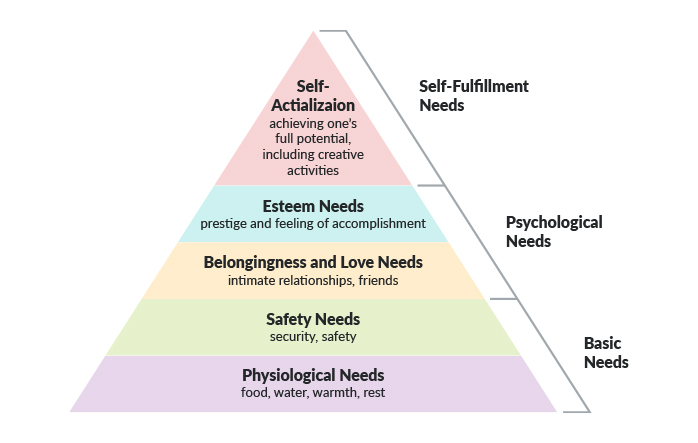Think back to the last time you felt truly valued as an employee. Maybe it was because you hit a project out of the park or reached a certain performance milestone on your job. Regardless of the circumstances, chances are that feeling of being valued was the result of some form of recognition that you received for your efforts or hard work. It’s a fundamental human need to want recognition or praise for an achievement – whether it be at work, on the playing field or at home.
Employee engagement begins with employee needs
 According to Maslow’s Hierarchy of Needs, we human beings have significant esteem and self-actualization needs. Esteem needs include respect for oneself but also the desire to accrue a positive image and reputation in the eyes of others. Maslow’s now-famous work placed self-actualization at the top of the pyramid, which can be summarized as a desire to fulfill one’s personal potential, live peak experiences or "become everything one is capable of becoming.”
According to Maslow’s Hierarchy of Needs, we human beings have significant esteem and self-actualization needs. Esteem needs include respect for oneself but also the desire to accrue a positive image and reputation in the eyes of others. Maslow’s now-famous work placed self-actualization at the top of the pyramid, which can be summarized as a desire to fulfill one’s personal potential, live peak experiences or "become everything one is capable of becoming.”
Meanwhile, needs lower on the pyramid must be fulfilled before higher needs can be realized. Someone in search of food, water and shelter is unlikely to be concerned with prestige and accomplishment, for example. This same hierarchical pattern is applicable to the work environment and should be top of mind as you ponder employee recognition ideas as a means of driving higher employee engagement.
Employee recognition programs really do work
More than 80% of HR leaders responding to the SHRM/Globoforce Employee Recognition Survey said that their employee recognition programs help with the employee experience, employee relationships, organizational culture, employee engagement and organizational values. Clearly, recognition touches so much of a company’s culture that it needs to be considered more than a program and should be treated as part of the fabric of an organization.
The reason is simple. When employees feel appreciated, valued and recognized for their work, they are more likely to put forth the type of discretionary effort described in our prior post on employee engagement. This, in turn, translates to increased employee retention, lower employment costs and higher bottom-line profitability. Want employees to work harder and care more? Make sure they feel recognized.
7 tips for bringing employee appreciation ideas to life
Motivating people is an art. It also can be surprisingly simple. To a large extent, it all boils down to the Golden Rule which says, “Do unto others as you would have others do unto you.” If you want to help fulfill your employees’ esteem needs, just remember these seven tips:
#1: Employee recognition awards don’t have to be expensive
Rewards don’t have to cost a lot to make an impact. Sincerity and thoughtfulness can make employees feel appreciated even more than cash rewards can. For example, giving an employee time to pursue a pet project costs very little but could have a huge payback on employee engagement – and for your business. The reward itself doesn’t even have to be tangible. Many companies use “what I appreciate about you” note cards to great effect. Managers and co-workers write private, heartfelt notes to express their thanks to others in the moment while the sentiment is fresh. A few kinds words at the right time can be priceless.
#2: Frequency is needed for employee recognition programs to work
Be sure to recognize employees regularly, not just once a year during a performance review. The appreciation notes mentioned in #1 above are especially effective for this very reason; because they aren’t tied to the business calendar, such notes facilitate sincerity, spontaneity and immediacy. By reinforcing and rewarding positive behaviors throughout the year as they happen, you will likely have much bigger accomplishments to discuss at the end of the year.
#3: Employee recognition must be fair and transparent
Dole out recognition fairly. If there is even a perception of unfairness or favoritism, employees will balk and the recognition strategy will lose its value. Make sure all roles and levels within the organization have an equal opportunity to be recognized in a comparable fashion. Nothing is more demotivating than feeling like you’re not “one of the cool kids” in the corporate culture. And, if the recognition program is tied to a standard set of performance metrics or outcomes, publish that information continuously so the award does not feel sudden or arbitrary to others.
#4: Keep the awards fresh and interesting
Build in surprises. Giving employees the same things year after year as recognition can grow stale quickly. Sprinkling in unexpected rewards or recognition can keep your program fresh and interesting. You could even allow the recipient to choose their form of recognition. For example, imagine a reward program that allowed the employee to choose from extra PTO days, a financial award, or a gift card for a favorite airline or retailer – all of similar perceived dollar value. Doing something of this nature would make the recognition process itself something of an adventure for the recipient.
#5: Design a recognition program that gets talked about
Make the recognition itself something employees will want to talk about. People generally feel uncomfortable discussing financial awards and cash, for example. Recognizing employees in new and different ways can make it easier for them to talk about it with co-workers and can incentivize underperforming employees along the way.
#6: Align the recognition with the employee’s personality
Some people love being the center of attention and being recognized publicly in a team setting is an enormous motivator. Conversely, some people are mortified by the mere thought of being called out in front of others – even for something praiseworthy – and this form of recognition would be extremely detrimental to their engagement. For them, a private conversation behind closed doors or a casual lunch out of the office would be ideal. Recognition is not a one-size-fits-all endeavor. Make an effort to tailor the form and format of the recognition to the personality type of the individual being recognized.
#7: Technology and employee recognition are a perfect fit
Digital technology has changed rewards and recognition in the workplace forever. Holistic, technology-driven rewards and recognition platforms allow organizations to deliver personalized rewards in a way that wasn’t possible just a few years ago. Here’s how to put a modern, digital spin on employee rewards:
- Establish a website to serve as the foundation of your program. Design it with your employees in mind and make sure it reflects your brand and goals.
- Make the site easily accessible by ensuring mobile compatibility. That way, employees can stay continuously informed of their “status” in the program and conveniently choose awards that appeal to them when they achieve the desired outcome.
- Unique delivery technology can heighten the value of the award itself. For example, music and digital tokens can enhance the employee experience surrounding the award. Haptic technology is another way to increase employee engagement by incorporating the sensations of touch, motion and/or vibration for the recipient.
Next time: The hottest trends in rewards and recognition
The benefits of employee engagement are well documented. Simply put, engaged employees tend to be happier and more productive. However, there are many schools of thought on how best to make that happen. Our third and final blog post in this series will explore the hottest trends in rewards and recognition, including one – peer-to-peer recognition – that invites employees to shape their own workplace culture.










